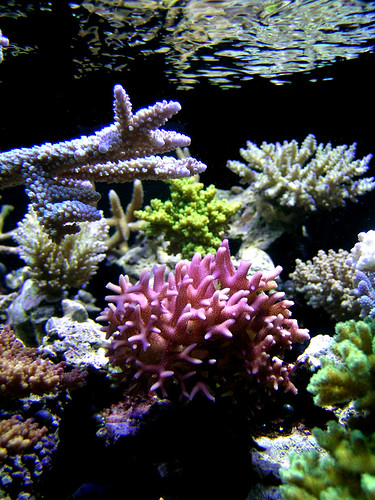Here we are once again. Monday is upon us and the time for science talk is here. Time to brighten your day with selections from science sites across the globe. New discoveries, new takes on old knowledge, and other bits of news are all available for the perusing in today's information world. Today's tidbits include a study says the Hawaiian Islands are dissolving, the black piranha has one of the most powerful fish bits of living or extinct species, the death of Hemlock trees offers new opportunity for hardwoods but at what cost to the ecosystem, and stars reveal the secret of aging well.
Pull up that comfy chair and grab a spot on the porch. There is always plenty of room for everyone. Another session of Dr. Possum's science education, entertainment, and potluck discussion is set to begin.
Featured Stories
If these scientists are correct one day the Hawaiian Islands will be low lying and flat like Midway Island is today.
The research pitted groundwater against stream water to see which removed more mineral material. Nelson and his BYU colleagues spent two months sampling both types of sources. In addition, ground and surface water estimates from the U.S. Geological Survey helped them calculate the total quantity of mass that disappeared from the island each year.
...
Forecasting the island’s future also needs to account for plate tectonics. As Oahu is pushed northwest, the island actually rises in elevation at a slow but steady rate. You’ve heard of mountain climbing; this is a mountain that climbs.
According to the researchers’ estimates, the net effect is that Oahu will continue to grow for as long as 1.5 million years. Beyond that, the force of groundwater will eventually triumph and the island will begin its descent to a low-lying topography.
From the land of who could have guessed or observed comes news of the
powerful bite of the black piranha.
Piranhas’ aggressive nature, relatively small size and accessible populations make them a suitable group of predatory vertebrates in which to study the evolution of extreme biting capabilities. Even at their small body sizes, diet studies indicate that piranhas will attack and bite chunks of bony fins and flesh from prey many times larger than themselves.
In spite of their reputation, no quantitative data or empirical estimates regarding the piranhas biting abilities were available.
The paper reports the first bite-force measurements taken from wild specimens of the largest species of carnivorous piranha in the Amazon, the black piranha, and describes the underlying functional morphology of the jaws that allows this creature to bite with a force more than 30 times greater than its weight. The powerful bite is achieved primarily due to the large muscle mass of the black piranha’s jaw and the efficient transmission of its large contractile forces through a highly modified jaw-closing lever.
As
Hemlock populations throughout the Eastern United States are being decimated by the pest, the hemlock woolly adelgid, the population of forest trees is changing.
The hardwood trees were able to grow because, when the hemlock trees died, phosphorus was released and became available to the hardwood species in the area. The increase in available phosphorus stimulated the growth of existing hardwood trees, which then increased tree demand for nitrogen. As a result, we saw less nitrogen being leached from the soil. Without hemlock mortality, the hardwood trees could not take up the excess nitrogen in the soil because their growth was limited by a lack of phosphorus.
The change may be good for the hardwood industry but the loss of a foundation species such as the Hemlock may have far reaching consequences.
As humans continue to fight aging and wish to look young stars have found the secret to appearing younger.
Star clusters form in a short period of time, meaning that all the stars within them tend to have roughly the same age. Because bright, high-mass stars burn up their fuel quite quickly, and globular clusters are very old, there should only be low-mass stars still shining within them.
This, however, turns out not to be the case: in certain circumstances, stars can be given a new burst of life, receiving extra fuel that bulks them up and substantially brightens them. This can happen if one star pulls matter off a neighbour, or if they collide. The re-invigorated stars are called blue stragglers [1], and their high mass and brightness are properties that lie at the heart of this study.
Knucklehead's Photo of the Week
Coral Junction

©Knucklehead, all rights reserved, presented by permission. (Click on the image to see more in the same series.)
Other Worthy Stories of the Week
7 Codes you'll never break
29 Years of inspiring Earth images from space
The year's best microscope views of biology
Cellphone, GPS data suggest new strategy for alleviating traffic tie-ups
Closest sun-like star may have planets
Clays on Mars: More plentiful than expected
Archeologists date world's oldest timber constructions
Suspend crystals and they grow better
The secret of nanoparticle packing in cement
Research shows rapid warming on the west Antarctic ice sheet
Smaller Colorado River predicted for coming decades
Just how big can black holes get?
The solar wind is swirly
For even more science news:
General Science Collectors:
Alpha-Galileo
BBC News Science and Environment
Eureka Science News
LiveScience
New Scientist
PhysOrg.com
SciDev.net
Science/AAAS
Science Alert
Science Centric
Science Daily
Scientific American
Space Daily
Blogs:
A Few Things Ill Considered Techie and Science News
Cantauri Dreams space exploration
Coctail Party Physics Physics with a twist.
Deep Sea News marine biology
List of Geoscience Blogs
Science20.com
ScienceBlogs
Space Review
Science Insider
Scientific Blogging.
Space.com
Techonology Review
Tetrapod Zoologyvertebrate paleontology
Wired News
Science RSS Feed: Medworm
The Skeptics Guide to the Universe--a combination of hard science and debunking crap
At Daily Kos:
This Week in Science by DarkSyde
Overnight News Digest:Science Saturday by Neon Vincent. OND tech Thursday by rfall.
Pique the Geek by Translator Sunday evenings about 9 Eastern time
All diaries with the DK GreenRoots Tag.
All diaries with the eKos Tag
A More Ancient World by matching mole
Astro Kos
SciTech at Dkos.
Sunday Science Videos by palantir
NASA picture of the day. For more see the NASA image gallery or the Astronomy Picture of the Day Archive

NGC5189, NASA, Public Domain


